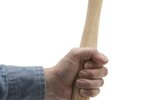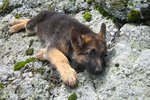
Most bearded dragons tolerate spending moderate amounts of time interacting with their keepers, outside of their cage. However, bearded dragons are individuals with varying degrees of tolerance for such excursions. To avoid causing your pet stress, observe his behavior during and after such sessions. Additionally, it is important to use an appropriate holding container when traveling or tending his cage to keep him safe and comfortable.
The Comforts of Home
While you must periodically remove your bearded dragon from his cage, remember that the climate in his enclosure -- where he is comfortable -- is much different from that of your air-conditioned living room. Once outside of the ideal conditions and low-stress environment inside his cage, he will become increasingly uncomfortable over time. Though short excursions -- measured in minutes, not hours -- outside of his cage are fine, it is always important to return him before he becomes stressed. Anytime you remove your bearded dragon from his cage, it should be in a quiet room, devoid of pets, loud radios and similar sources of stress.
Personality Test
Because of the differences in the personalities of bearded dragons, you must observe the way your individual pet behaves. Return him to his cage if he exhibits signs of stress, rather than relaxed or exploring behaviors. Stressed bearded dragons may close their eyes, gape their mouths, distend their beard, bite or repeatedly attempt to run away. Relaxed bearded dragons generally remain still or walk around slowly; exploring dragons may cock their head from one side to the other or lick the ground. Observe your bearded dragon’s behavior once he is back in his cage as well -- if he eats, drinks and behaves normally after being returned, then he was probably not troubled by the excursion. Signs of depression, anorexia or irritation indicate that you must reduce the duration of excursions in the future.
Clean Your Room
When tending to your bearded dragon’s cage, remove him and place him in a temporary holding container. The holding container should be clean and either have a lid or be tall enough that he cannot escape. You can also soak your pet in chest-deep water while you clean his cage. A brief soak will help to ensure that your bearded dragon stays properly hydrated, and is nice and clean when he returns to his newly cleaned cage. However, soaking frequently causes bearded dragons to defecate in the water. If this happens, change the water immediately so that he does not soak in, or drink from, fouled water.
Traveling Tails
If your bearded must visit the vet, or accompany your family on a trip, use an appropriate traveling vessel -- potentially the same one you use during cage cleanings. The best choice is a medium-sized, opaque, plastic storage container. Place some crumpled newspaper or a soft cloth towel in the container to ensure your pet is comfortable for the ride. Cut, melt or drill several 1/4-inch holes into the lid of the container to provide ventilation. Though your bearded will adapt to the occasional several-hour-long trip, limit trips as much as possible.
References
- University of Miami: Caring for an Australian Bearded Dragon
- Dachiu Bearded Dragons: Care Information
- Melissa Kaplan's Herp Care Collection: Dragons Down Under: The Inland Bearded Dragon
- Michigan State University, Veterinary Teaching Hospital: Care and Feeding of Bearded Dragons
- Animal Diversity Web: Pogona Vitticeps
Photo Credits
-
Creatas/Creatas/Getty Images




